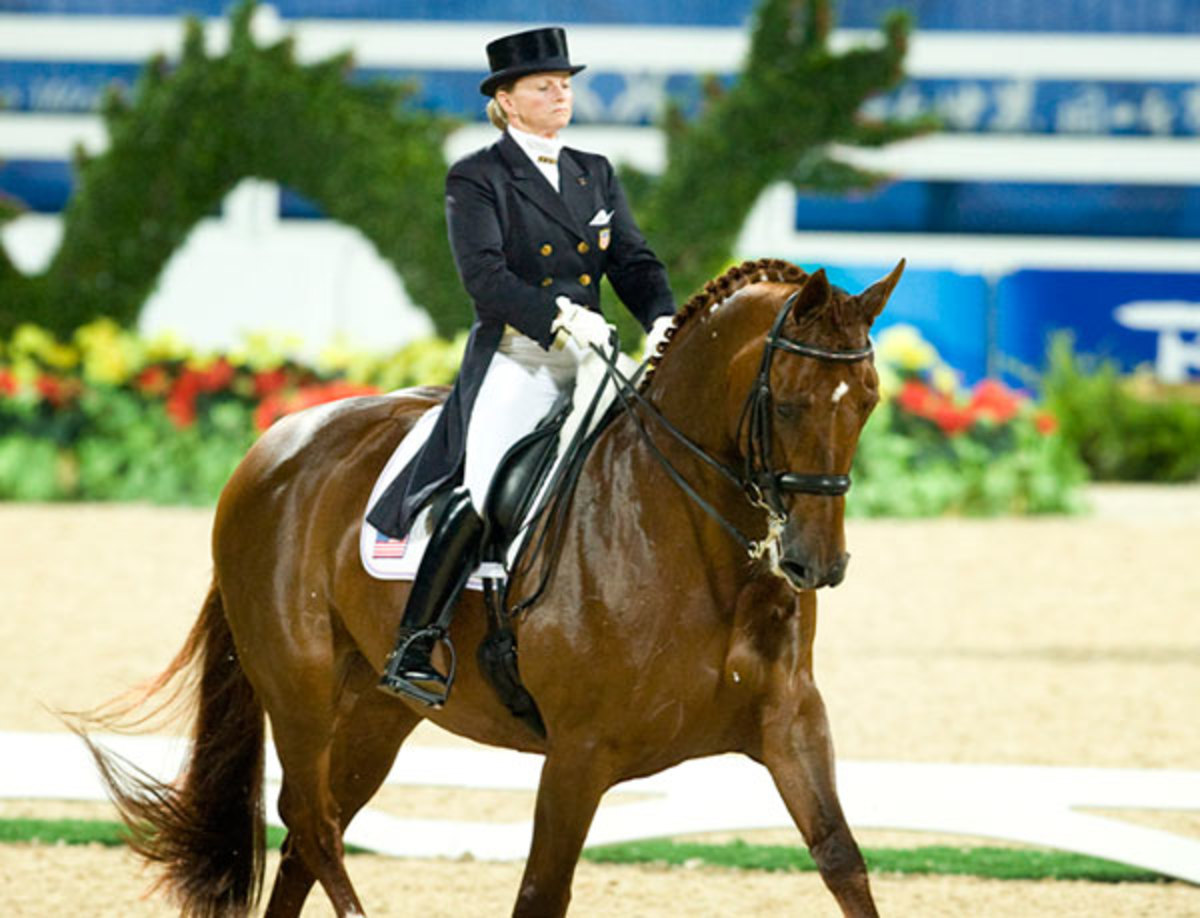Q: I ride a 16.2-hand, 10-year-old Holsteiner gelding. His trot is huge and his back long, and since he’s not quite connecting yet, I’m having a really hard time with the sitting trot. It’s quite a rough trot. I’m 5’4” tall. Could you give me advice on how I can sit the trot better? I feel in the posting trot it’s quite hard to influence him with my aids and connect him.—Lindsay Groff of Aurora, Colorado
A: You happened to ask me a question that is easy for me to relate to since I have a large-boned, 17.1-hand Holsteiner gelding in training who has a long back and a huge trot! At first, Leon was very uncomfortable in trot and canter. I find most horses who haven’t had good dressage training and don’t have a well-developed topline are difficult to sit. There is not a simple answer, but I will describe how I cope with this problem.

I start by improving the horse’s gaits. In Leon’s case, I didn’t even consider sitting his trot in the beginning. I needed to make him more reactive and sensitive to lighter aids. I do quite a bit of lateral work in the warm-up at the walk with every horse. That gives me the chance to explain obedience to the leg and hand without the difficulty of a slow, rough trot or canter. Once I have awakened the response to my leg and hand at the walk, I start transitions from walk to trot. First I use a gentle squeeze with both legs. If the horse doesn’t respond quickly, I give him a really hard boot with both legs, even the spurs and whip if necessary, until just shortening the reins a little and a warning bump from my lower leg makes the horse prepared to react.
While I was sensitizing Leon to my leg, I rode him with a very light hand. I didn’t care if he connected in the “classical” sense; I just wanted him to go when I asked. Then I started asking him to go with the same technique from the posting trot—letting him slow down, then closing both my lower legs and asking him to really move out.
I did the same in canter. I let him slow down and then asked him to push himself up and forward when I closed my legs and lightened my seat. In the beginning, posting the trot during the thrusting phase gave his back room to come up, and sitting was not a priority. He got the idea of pushing himself from back to front pretty well, but it caused him to fall on the forehand. The next step was to teach him to respond to a half halt.
There are different types of half halts, but they all have the same purpose, which is to re-establish balance. At first, I used what I call a “full body half halt” to help Leon balance. Full body means a short, strong contracting action against the downward weight of the horse’s front end. My seat and legs support the tightening of my upper core, fingers and latticimus dorsi muscles.
I often use a leverage metaphor to describe the feeling to a student. The challenge is to time the half halt so that you are not “pulling the horse up,” but instead preventing the horse from hitting the ground so heavily on the forehand. As a shorter rider, you will need to be even better at using the half halt at the right time. But I promise, it is possible!
As Leon got stronger and carried himself forward more consistently, I was able to produce better balance by just closing my fists briefly on the reins when I felt him falling on the forehand. I call this a “rein half halt.” This made it easier for him to sit without slowing him down. As he got more responsive to the “go” aids and the half halts, his back started to come up and his movement became more elastic and easier to sit. Then, I could ask him for a better connection over his back through the outside rein. I achieved that riding shoulder-in, which brought his inside hind leg more under his center of gravity both laterally and longitudinally. When I had that connection over his back through the outside rein, I could start straightening him by doing more lateral work, such as shoulder-in and renvers.
You have to accept the fact that the outlined procedure will be strenuous work for you both. We have a long hill on our property at Malibu Creek, and every other day I would save enough energy in his tank to trot up the hill at the end of the arena work. Week by week, I could feel his body become stronger and more responsive. Now, he looks like a linebacker rather than the gangly juvenile that first walked into the stable.
Today when I was riding Leon, I thought about your question again. Another training technique I use for sitting big, uncomfortable horses is to consciously start the warm-up trot in a faster-than-normal tempo. Something I learned from training many upper-level horses is how to make the harder exercises easier by quickening the tempo. Some horses are heavy movers and are jarring to the rider just because their tempo is too slow. Speeding them up a little gives them better balance and the ability to be lighter on the forehand. The rhythm may be clear, but if the tempo is too slow, fatigue sets in and the movement will fail.
Humans and horses have slow- and fast-twitch fibers in all their muscles. All creatures have a tendency to be more of one type than the other. Dressage horses are like gymnasts and ballet dancers: They need a lot of muscle development to have the strength necessary to perform the upper-level movements. Analyze your horse’s physical qualities and try varying the tempo to see what works for him/her. If your horse is the slow-twitch type, he might benefit from a quicker tempo. To help the horse understand what I want, I make my hip angle open and close quicker, along with a quicker action from my supportive lower leg. Remember to sit tall and be strong in your upper body, including your head and neck, so you don’t get sucked down into the horse’s long, slow tempo. The horse is your dance partner, but you have to be the leader in the dance.
Summing up, the answer to your question, how to sit a big trot, is to make your horse more reactive to lighter aids and teach yourself to establish the optimal tempo. Eventually, your strength and stamina training will pay off and you will be able to connect your horse from back to front on a consistent basis. You will always need to be tactful with your hands, as too much rein will slow your horse down and make the work hard again. If you run into a responsiveness problem, go back to the walk–trot transitions. Any problems you have are going to be a lot easier to deal with in the walk.

Kamila Dupont received her USDF gold medal in 1984 and spent several years showing in Europe. She trains out of Malibu Creek Equestrian Center in Agoura, California.











